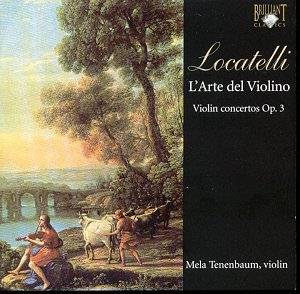These famously pyrotechnic concertos, some
of proto-Paganinian complexity, show a more public virtuosity
than the interior spirituality of, say, Biber's Mystery Sonatas.
Locatelli's own Sonatas - he wrote a number - certainly lack
the Bohemian composer's sense of profound engagement but then
Locatelli was writing from a different compositional axis; a
broadly Corellian-Vivaldian one that took an admixture of Handel
and larded it with moments of extreme, if (in our terms) rather
static melodrama. And his Concertos are certainly chin-juttingly
tough to play and have provided fiddle players with quite sufficient
difficulties over the years. The fearsome few tend to dig out
the solo sonatas - Ricci, Staryk, Kremer amongst them - whilst
such as the pioneering Lautenbacher have given us complete sets
of the concertos.
Adopting elements of the church sonata he
added finger busting double stops and exceptionally difficult
writing in the soprano register, playing that tests agility,
digital accuracy and intonation to the maximum. All the concertos
contain caprice-cadenzas, moments when the soloist lets loose
with a battery of florid cadential dramas – not for nothing
was Locatelli known colloquially as The Earthquake. Slow
movements are lyrically etched, such as the first in D major.
Opening movements, as often as not Andantes, can move, as in
the case of the C minor [No.2] with noblest of treads whereas
Vivace finales can tend toward the vocalised and possess real
lyric generosity, though there are dangers aplenty.
Such things may seem schematic but Locatelli
cannily varies texture and tone; the stratospheric finger board
work in the concertante parts of the E major [No.4] are contrasted
with the greater concentration on the lower strings in the powerhouse
cadenza. And lest one think him a flâneur, melodically speaking,
he spins a haunting Largo in the same Concerto. He also manages
to spice up a compositional trick whereby the spaced orchestral
chordal introductions to the slow movement become, over time
and as the concertos develop, quicker. The move generally is
toward a greater concision of utterance and a greater compression
of musical ideas, even if in the case of the Largo of No.11
it has become generic through overuse, and even though the last
of the twelve, the G major Facilis aditus, difficilis exitus
(an appropriate Latin tag), has an inordinately long
but clever finale – the longest single movement of any of the
concertos.
The principal competition to this newly released
set of the cycle made by Mela Tenenbaum between 1994-98 is the
set of recordings made in 1990 by Rudolfo Bonucci and the Orchestra
da Camera di Santa Cecilia on Arts 4772-2, a four CD set in
a handy slipcase. Differences are plentiful. In the main Bonucci
is more leisurely in terms of tempi and the harpsichord is much
more audible in the recorded balance. Tenenbaum was recorded
with three different orchestras though all were directed by
Richard Kapp and one senses their greater incision throughout.
That said I can’t hear a harpsichord in the First Concerto in
the Brilliant performance and the cello continuo line is rather
submerged. Against that I welcomed the Brilliant team’s greater
attention to expressive diminuendi and lighter tone. The recording
venues obviously changed for the new team and that is reflected
in the rather less immediate sound generally in comparison with
the sturdy Arts sound. Interpretatively the Bonucci team tends
to more old-fashioned notions of expression whilst the Brilliant
tend to accent with great rhythmic impetus. That this is not
a question of tempo can be evidenced by the performances of
baroque violin music of Andrew Manze who’s never afraid to indulge
a slow tempo in the interests if emotive depth. I admired rather
more the sense of paragraphal sculpting Tenenbaum finds in the
Largo of the Seventh Concerto and also her rather greater tensile
strength. Robust though they are the Arts team has to cede to
the Brilliant in the concluding Allegro of the Ninth in terms
of imaginative colour.
In the virtuosic demands of the last three
of the set we find Tenenbaum fearlessly tossing off passagework
– though Bonucci is no slouch and his harmonics are splendid.
The Labyrinth Concerto, the Twelfth, sounds very much
more innovatory and revolutionary in this new recording than
it does with Bonucci, who tends to present a more patrician
front and by implication to relate it much more to the earlier
concertos in the set, giving it a greater expressive consonance.
With Tenenbaum and Kapp you are also aware of the radicalism
that runs throughout and the colour is altogether different;
in fact they could be playing different editions their performances
are so different in almost every respect.
My choice would be for the Brilliant team
over the Arts though I should say that though Bonucci’s intonation
is occasionally compromised somewhat and there are instances
of strained passagework he remains elegant and generally unruffled
by the exorbitant demands placed on him. Tenenbaum and Kapp
take Locatelli more by the scruff of the neck and the vitality
and innovation of the music is perhaps better revealed in their
performances, imperfect though they may sometimes be.
Jonathan Woolf

![]() Mela Tenenbaum (violin)
Mela Tenenbaum (violin)![]() BRILLIANT CLASSICS 92608
[4 CDs: 65.27 + 50.58 + 56.30 + 57.48]
BRILLIANT CLASSICS 92608
[4 CDs: 65.27 + 50.58 + 56.30 + 57.48]





